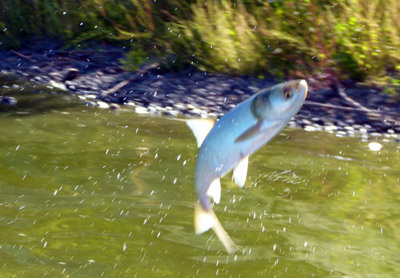Centennial Fountain

Back to Centennial Fountain
Back to Centennial Fountain
One of the biggest threats
You may have heard of Asian carp and the threat they pose to the health of the Great Lakes. These fish are examples of aquatic invasive species (AIS), plants and animals brought here from other parts of the world, often accidentally, that multiply rapidly and push out native species. AIS cause ecological and economic harm and create problems for recreation.
Asian carp are known for their appetites. They can grow to about 50 pounds by consuming large amounts of microscopic creatures that form the base of the food chain. These voracious eaters have nearly wiped out food supplies in the Mississippi and Illinois rivers and have the potential to devastate native fish in the Great Lakes.
Two species of Asian carp – bighead and silver carp – are closing in on Lake Michigan. To stop them in their tracks, the U.S. Army Corps of Engineers has installed an electric barrier in the Chicago Sanitary and Ship Canal. Despite this, Asian carp DNA and a live bighead carp have been found beyond the barrier. Concerned that electric barriers are, at best, only a temporary solution, there is interest in separating the Great Lakes and Mississippi River, returning the system to what it was before flow of the Chicago River was reversed in 1900.
Unlike many bottom-feeding carp species, Asian carp are filter feeders. As a result, their meat tastes mild, making them a popular food fish in much of the world. Some see the large numbers of these fish in the Mississippi and Illinois rivers as an opportunity to sell them in international markets, as well as in local grocery stores and fish markets. After all, if you can't beat 'em, eat 'em.
Asian carp are known for their appetites. They can grow to about 50 pounds by consuming large amounts of microscopic creatures that form the base of the food chain. These voracious eaters have nearly wiped out food supplies in the Mississippi and Illinois rivers and have the potential to devastate native fish in the Great Lakes.
Two species of Asian carp – bighead and silver carp – are closing in on Lake Michigan. To stop them in their tracks, the U.S. Army Corps of Engineers has installed an electric barrier in the Chicago Sanitary and Ship Canal. Despite this, Asian carp DNA and a live bighead carp have been found beyond the barrier. Concerned that electric barriers are, at best, only a temporary solution, there is interest in separating the Great Lakes and Mississippi River, returning the system to what it was before flow of the Chicago River was reversed in 1900.
Unlike many bottom-feeding carp species, Asian carp are filter feeders. As a result, their meat tastes mild, making them a popular food fish in much of the world. Some see the large numbers of these fish in the Mississippi and Illinois rivers as an opportunity to sell them in international markets, as well as in local grocery stores and fish markets. After all, if you can't beat 'em, eat 'em.
